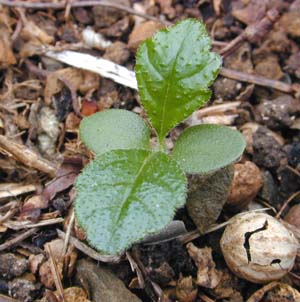Cotyledon: Difference between revisions
Jump to navigation
Jump to search
No edit summary |
No edit summary |
||
| Line 10: | Line 10: | ||
Other species of Cotyledon occur in collections of succulent plants, but the following probably represent those of commerce in this country. | Other species of Cotyledon occur in collections of succulent plants, but the following probably represent those of commerce in this country. | ||
Many garden names occur in Cotyledon, some of which are unidentifiable and some of which probably represent hybrids. C. devensis, Hort. Hybrid between probably C. glauca and C. gibbiflora: fl.-sts. 5-7 ft. long. B.M. 8104.—C. elegans, N. E. Br.= Oliveranthus.— C. eximia, Hort.=(7). — C. globosa, Hort., see page 1087.—C. globulariaefolia. Baker. Rosulate, 8 in.: lvs. 30-40, obovate-spatulate, 2½ in. or less long: fls. white tinged red, 20-40 in a dense thyrse-like cluster. Syria.—C. imbricata, Hort.. described on p. 1087.—C. insignis, N. E. Br. About 2 ft., wholly glabrous, erect, light green: lvs. opposite, broad, to 5 in. long: fls. light red with lobes greenish yellow inside, 1½ in. long, in terminal and axillary cymea. Cent. Afr. B.M. 8036.—C. mirabilis, Hort..hybrid. —C. mucronata, Baker.=Echeveria, p. 1086.—C. nano, Marl. Very dwarf, 1½ in. or less high, densely branched and forming a tuft: lvs. yellowish green, not apiculate. S. Afr.—C. Peatalozzae, Mast. Lvs. distributed, the radical ones spatulate-obtuse and margins slightly denticulate, the cauline obovate-oblong: fls. pale rose, somewhat secund in a glandular-hairy panicle. Cilicia.—C. pulvinata, Hook. f. =Echeveria, p. 1086.—C. sedoides, DC. Annual, creeping, smooth: lvs. sedum-like, oblong and obtuse, convex: fls. few, pink, in summer. Pyrenees. Distinguished from Sedum by the gamopetalous corolla. — C. spinosus. Linn. Small and quaint, Apicra-like, with a rosette of flat spoon-shaped spine-tipped lvs., 12 in. or more tall: fls. yellow, in early summer. Siberia to China and Japan, but not hardy.— C. superba, Hort., is an annual with yellow fls.—C. teretifolia, Thunb. St. somewhat woody, 6-8 in. high, simple or branched: lvs. 4—5 in. long, opposite, nearly terete, acute or cuspidate, hirsute or subglabrous: fls. many, corymbed, the peduncle to 18 in., yellow; corolla-tube a little shorter then calyx. S. Afr. L. H. B. | |||
}} | }} | ||
[[Image:Seedling_cotyledons_small.jpg|thumb|right|This [[seedling]] germinated producing two plain-looking cotyledons later followed by two normal-looking leaves that are small copies of the adult leaves.]] | [[Image:Seedling_cotyledons_small.jpg|thumb|right|This [[seedling]] germinated producing two plain-looking cotyledons later followed by two normal-looking leaves that are small copies of the adult leaves.]] | ||
Revision as of 10:53, 9 August 2009
| Standard Cyclopedia of Horticulture |
|---|
|
{{{1}}} The above text is from the Standard Cyclopedia of Horticulture. It may be out of date, but still contains valuable and interesting information which can be incorporated into the remainder of the article. Click on "Collapse" in the header to hide this text. |

Seed-leaf; the primary leaf or leaves in the embryo; in some plants the cotyledon always remains in the seed-coats and in others (as bean) it emerges on germination.
Gallery
-
cotyledon in formation before the accumulation of the reserves seen at Judas-tree (Cercis siliquastrum)
-
Comparison of a monocot and dicot sprouting
-
A seedling of Maritime Pine with eight cotyledons
| This article contains a definition from the Glossary of Gardening Terms. |


